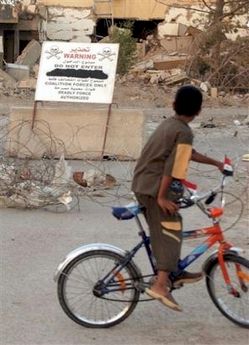Gorilla's Guides: What Was That We're All Meant To Be "Pro" Again? Part 2
I blogged about this episode on Wednesday May 31st. Gorilla's Guides: What Was That We're All Meant To Be "Pro" Again? Here's part of what I said back then:
Dahr Jamail working with Arkan Hamed has further updates to this story. The article which can be found here confirms the many of the details previously known such as the US army's initials statement: "Shots were fired to disable the vehicle," the military said in a statement e-mailed to The Associated Press. "Coalition forces later received reports from Iraqi police that two women had died from gunshot wounds ... and one of the females may have been pregnant." As I said at the time there was no "may have been about it" - the US army admitted killing both Nabiha Nisaif Jassim and her cousin Saliha Mohammed Hassan. As Nabiha was being raced to the maternity hospital to give birth to her third child. The US army statement made two claims:
Both points are disputed by the driver of the car Nabiha's brother Khalid Nisaif Jassim, and two local residents back his version of events up.
Dahr Jamail's and Arkan Hamed's report again confirms what I wrote back on May 31st. That the checkpoint as is almost invariably the case with US checkpoints took place at a concealed checkpoint. It wasn't easy to see, it wasn't meant to be.
[These are the so-called "Solatia Payments" and are not an admission of liability see notes at the end of this posting - mfi] In short we still have a situation where a mother of two being rushed to give birth in the local maternity hospital was, together with her 57 year old cousin shot from behind by a concealed sniper, and died as a result. Efforts to save her baby were unsuccessful. The incident took place at what appears to have been a concealed checkpoint, the existentce of which was not notified to the public at the time it was erected, and was indeed only signposted the next day. Moreover all witnesses specifically contradict the US version of events and at the very least questions as to why payment was offered. There are good grounds for suspecting that as in Haditha [see in particular note 4 in the notes below] the motive was not "to express sorrow" but rather it was species of "hush money." markfromireland Notes Note 1:
See: Notes from the field. For general legal background on Solatia. [ One of the particular examples used is a vehicle approaching a checkpoint at a high rate of speed. If soldiers fire on that vehicle that is a combat-related incident, and cannot be compensated under the Foreign Claims Act, but if innocent civilians are killed, the local Commander can make a payment from what are called CERP funds to compensate victims/relatves. Briefly the legal situation is that while foreign nationals may claim for injury or damage caused by the the US under the Foreign Claims Act, such claims may not be made under the FCA for combat injuries or death. In such a case "Solatia" payments are made as "an expression of sorrow" they are discretionary and ex gratia " made under the "Commanders Emergency Response Program" (CERP). CERP Payments have have rocketed in the the last year. Particularly from the United States Marine Corps (USMC.) To an extent this reflects the intensity of combat in al-Anbar (Samarra is in Salah ad Din.) Note 2: See:
Note 3: also see:
Note 4: A particular point to note is no money is paid to Iraqi's killed by insurgents. This was, to me at any rate one of the first indisputable indications that a cover up in Haditha had been attempted by the local commanders. The payments are made solely as a result of US actions and are made at the discretion of the local commander. In Haditha the US army first claimed that the 24 in Haditha had been killed by insurgents and then paid them. Clearly a HUGE discrepency between policy and what was done. The question immediately arose in my mind as to why the money was paid. The only reasonable explanation is as "hush money." Note 5: Readers should also note that given that the payment for a death is US$2,500.00 payments in the order of US$19 million implies a massive number of civilian deaths many thousands of civilians deaths. Yet the admitted total of civilian deaths is considerably less than 1,000 - in the order of 600. markfromireland cross posted to markfromireland |

 "The caption for this photo reads as follows:
"The caption for this photo reads as follows: The report confirms moreover that in this case as in so many others the victims were shot from behind by a concealed American sniper and that US troops made no attempt to help their victims.
The report confirms moreover that in this case as in so many others the victims were shot from behind by a concealed American sniper and that US troops made no attempt to help their victims.